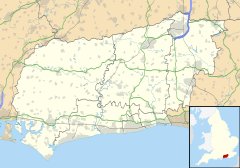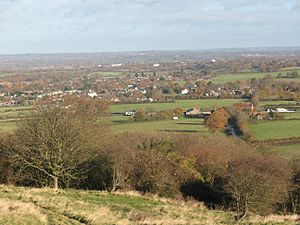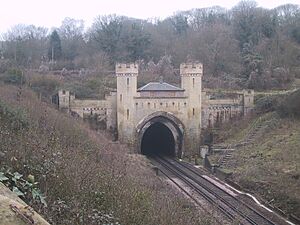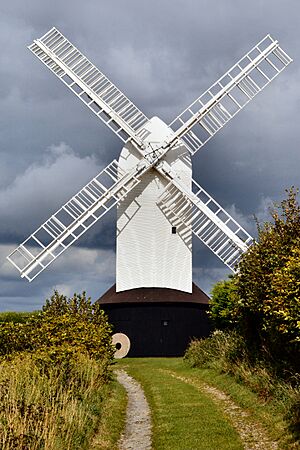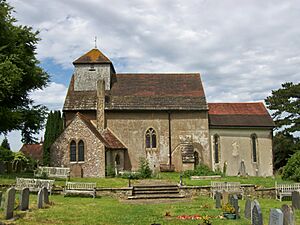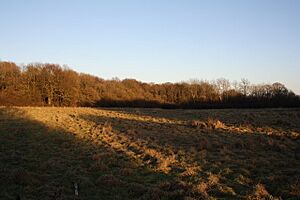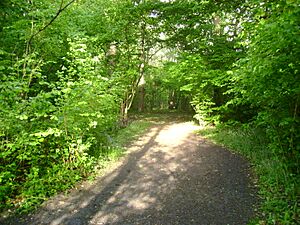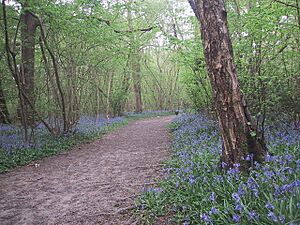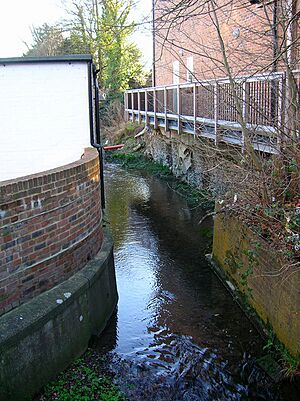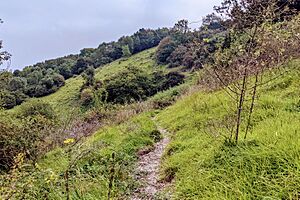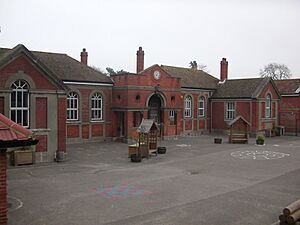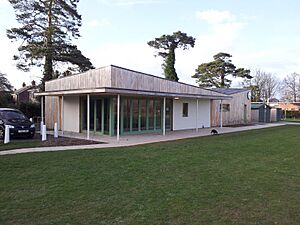Hassocks facts for kids
Quick facts for kids Hassocks |
|
|---|---|
| Village and civil parish | |
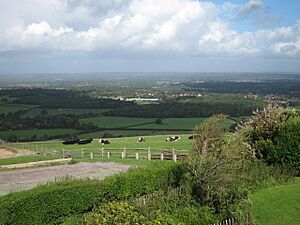 Hassocks viewed from the South Downs |
|
| Area | 10.88 km2 (4.20 sq mi) |
| Population | 7,667 2011 Census |
| • Density | 627/km2 (1,620/sq mi) |
| OS grid reference | TQ299154 |
| • London | 40 miles (64 km) N |
| Civil parish |
|
| District |
|
| Shire county | |
| Region | |
| Country | England |
| Sovereign state | United Kingdom |
| Post town | HASSOCKS |
| Postcode district | BN6 |
| Dialling code | 01273 |
| Police | Sussex |
| Fire | West Sussex |
| Ambulance | South East Coast |
| EU Parliament | South East England |
| UK Parliament |
|
| Website | http://www.hassockspc.net/ |
Hassocks is a lovely village in West Sussex, England. Its name might come from the small clumps of grass found in the fields nearby.
Hassocks is about 7 miles (11 km) north of Brighton. It has a population of 8,319 people. A long time ago, Hassocks was just a few houses and a place for coaches to stop. But in the 1800s, everything changed when the London to Brighton railway was built.
Before 2000, Hassocks was part of two different areas called Clayton and Keymer. Hassocks was just the name for the mail delivery area. When the railway station opened in 1841, the local councils couldn't agree on a name for it. So, the railway company decided to call it 'Hassocks Gate'.
Contents
- Hassocks History
- Hassocks Community Plan
- Cool Places in Hassocks
- Hassocks Railway Station
- Learning in Hassocks
- Sports and Fun
- Sister Towns
- Famous People from Hassocks
Hassocks History
Ancient Times to the 1800s
The South Downs, where Hassocks is located, have been home to people since the Stone Age, around 20,000 BC. Back then, Britain was still connected to Europe by land.
You can find an amazing Iron Age fort on top of Wolstonbury Hill nearby. This shows that people lived and protected themselves here thousands of years ago.
A Roman cemetery was discovered near Stonepound Crossroads. People think modern Hassocks was once a Roman crossroads. It was on the Roman road that went from London to the coast. Another Roman road, the Sussex Greensand Way, also crossed here. These roads helped connect farms and ironworks to London.
After the Normans took over England, much of this land belonged to the manor of Hurstpierpoint. It was part of a large common area. Later, in the 1800s, this common land was divided up. During this time, many brick factories and potteries opened, using the local greensand.
Modern Hassocks Develops
The opening of Hassocks Gate station on September 21, 1841, was a big moment. This station, now just called Hassocks, helped the modern village grow. South of the village, the railway goes through Clayton Tunnel. This tunnel is 6,777 feet (2,066 m) long and goes under the South Downs.
The north entrance of the tunnel looks like a castle, with a small house between two towers. This house might have been for the person who looked after the gas lights inside the tunnel. For many years, the tunnel was lit by gas lamps to help early train travelers feel safer. Sadly, in 1861, a train crash inside the tunnel killed 23 people.
In the 1930s, new homes were built in the Grand Avenue area. George Ferguson developed these homes on land that used to be orchards. He made sure that beautiful cherry trees were planted along the main roads.
When World War II started in 1939, the local cinema closed. Many children were evacuated from London to Hassocks, adding 1,250 people to the village.
Hassocks Community Plan
The Hassocks Parish Council has created a plan for the village's future. This plan helps decide how the village will grow and what new buildings might be needed. In March 2020, people in Hassocks voted on this new plan, and 94% supported it!
Cool Places in Hassocks
 |
Burgess Hill |  |
||
| Hurstpierpoint and Sayers Common | Ditchling | |||
| Pyecombe |
Hassocks has a village center and a popular community building called Adastra Hall. This hall is used for many different community events.
Two miles west of Hassocks, in the village of Hurstpierpoint, is Danny House. This old Elizabethan manor house was where important talks happened to end World War I.
On the hills above Hassocks, you can see two windmills, known as "Jack and Jill". They are officially called Clayton Windmills. Jack is a tower mill built in 1866. Jill, a post mill, was built in Brighton in 1821 and later moved to Clayton in 1852 by oxen! The mills stopped working around 1906. Jack is now a private home, but Jill was fixed up in 1986 and is open for visitors. To the northeast of the village, you can also find Oldland Mill.
Historic Buildings
Hassocks has 27 listed buildings. These are special buildings protected for their history and architecture. One of them is a Grade I building, which means it's very important.
- The Parish Church of St John the Baptist, Clayton: This is an Anglo-Saxon church famous for its beautiful 12th-century wall paintings. It's a Grade I listed building.
Other important listed buildings include:
- Ockley Manor: An early 18th-century house.
- Clayton Priory: A grand country house built around 1820.
- Clayton Windmills and the Millhouse Attached: These are the famous 'Jack and Jill' windmills.
Protected Ancient Sites
The area also has one scheduled monument, which is an important archaeological site:
- Round barrows West of Ditchling Beacon: These are four ancient burial mounds that are now flat from farming, but their remains are still underground.
Special Nature Areas
There's a Site of Special Scientific Interest (SSSI) in the parish called Clayton to Offham Escarpment. This area is very important for nature because it has rare chalk grassland, woodlands, and scrub.
Wonderful Woods
North of Clayton Tunnel and south of Hassocks village, there are several ancient woods. They are divided by the railway line and the A273 road.
Butcher's Wood
Butcher's Wood (TQ 303 149) is a small, ancient woodland. It's mostly oak and hazel trees, with a small group of hornbeam trees. In spring, the ground is covered with wood anemones and bluebells. The Woodland Trust owns this wood, and they work to help it thrive. Many songbirds, treecreepers, and nuthatches live here.
Lag Wood
Lag Wood (TQ 302 146) is a wet wood. The word 'lag' means "brook meadow" in old English. The area near the brook is full of different plants and animals. You can find hornbeam, hazel, and ash trees, along with wood sorrel and meadowsweet. The brook is home to giant craneflies.
Bonny's Wood
Bonny's Wood (TQ 299 147) is west of Lag Wood, across the railway tracks. It's an ancient woodland with many native species. It has oak and hazel trees, plus field maple, birch, and ash. The ground is covered with wood anemone and bluebells in spring.
Ockenden Wood
Ockenden Wood (TQ 297 148) is east of Bonny's Wood. It has lots of young trees and, like the other woods, is covered in bluebells and anemones. Managing this wood helps local wildlife.
Flowing Streams
Several clear chalk streams flow through Hassocks and into the River Adur. These streams are very important for local wildlife. Many watermills used to use these streams, and some still have clear, fast-flowing channels. The streams are home to fish like European bullhead and minnow, tiny mussels, freshwater shrimp, and three-spined stickleback.
Long ago, many streams were straightened to help drain the land and power mills. But some parts of the streams still have their natural winding paths.
Millbrook Shaw Stream
Millbrook Shaw Stream starts at Whitelands Reservoir and flows along Underhill Lane. This chalk stream (TQ 314 141) has clear, bubbling water over a gravel bed. Along its banks, you can see plants like golden saxifrage, wild garlic, wood anemones, and bluebells. Millbrook Shaw and the Clayton Stream join together at the south end of Hassocks to form the Herrings Stream.
Clayton Stream
The Clayton Stream flows behind Spring Lane (TQ 303 141). South of New Road, it forms a clear pond that was once used for washing sheep. North of the road, it winds through yellow flag flowers and hemlock water dropwort. It then flows through Lag Wood and Butcher's Wood before meeting the Millbrook Shaw Stream in Hassocks village.
Herrings Stream
The Herrings Stream begins where the Millbrook Shaw and Clayton Stream meet. It flows through the village, clean and bright, but it's often hard to spot. It passes just east of Hassocks Station and goes under Keymer Road at an ancient crossing point once known as Spitalford.
Friars Oak Area
On the northwest side of the village, along London Road, is the Friars Oak. This used to be a coaching inn. Nearby were open fields called Friars Oak Fields. These were old meadows with natural soil and ancient plants. This area is now being developed for new homes.
Clayton Wood Natural Burial Ground
Clayton Wood Natural Burial Ground opened in 2008. It's a 13-acre meadow where people can have natural burials, and a tree is planted over the grave. Over time, these trees will grow into a woodland within the new South Downs National Park. This area is already home to rare animals like soprano pipistrelle bats and great crested newts.
South Downs National Park
While most of Hassocks is in the Sussex Weald, the beautiful South Downs are to the south. This area is full of amazing plants and animals. It's also the western edge of the Clayton to Offham Escarpment, which is a Site of Special Scientific Interest.
Clayton Down
Clayton Down (TQ 305 136) is like a natural orchard! It has so many different plants. You can find blackberries, crab apple, sloe berries, and pink and orange spindle berries. There are many types of bushes, and many of them have colorful fruits.
Clayton Holt
Clayton Holt (TQ 310 134) is an ancient woodland on the downs. It's thought to be over ten thousand years old! It has many old woodland plants, including huge lime trees. It's also one of the best places on the Downs to see very old beeches trees. A rare flower called the lesser butterfly orchid has also been found here.
Hassocks Railway Station
Hassocks railway station serves the village. You can catch trains to Brighton, London Victoria, Bedford, and Cambridge. The station was rebuilt in 2013, with a new main building and lifts added to both platforms.
Learning in Hassocks
Hassocks Infant School is for children aged 4 to 7. It was built in 1877 as a Victorian school. Today, it has about 270 students and has been made much bigger with new classrooms and a large hall.
For junior education, children in the village go to Windmills Junior School.
Older students attend Downlands Community School for their secondary education. Downlands doesn't have a sixth form, so students who want to study for 'A' levels travel to colleges like Varndean College or Brighton Hove & Sussex Sixth Form College. Downlands Community School has a sports hall and an AstroTurf football pitch, which were funded by the wife of the late Chelsea F.C. vice-chairman Matthew Harding.
Sports and Fun
In 2010, the old sports pavilion was replaced with a new, eco-friendly building. This new building opened in April 2011 and uses modern technology like air source heat pumps.
Adastra Park has several football pitches where both junior and senior games are played. It's also the home of Keymer & Hassocks Cricket Club. The park also has a skate park and two playgrounds for kids of all ages. Sometimes, a 5-a-side football competition is held here in August.
Hassocks F.C. plays football at the nearby Beacon Ground. There are also three public tennis courts in Adastra Park, and the 'Weald Tennis and Squash Club' is a big club in the village.
Hassocks Sports Centre is located at Downlands Community School. It has an indoor sports hall, a dance studio, a full-sized artificial football pitch, and a gym.
Sister Towns
Hassocks has two "twin towns" or "sister cities" that it shares a special friendship with:
 Montmirail in France.
Montmirail in France. Wald-Michelbach in Germany.
Wald-Michelbach in Germany.
Famous People from Hassocks
- Austen Albu (1903–1994): A former British politician who lived in Hassocks.
- Martin Dugard: A motorcycle racer.
- Patrick Hamilton (1904–1962): A famous playwright and novelist who was born in Hassocks.
- Jonathan Pearce: A well-known football commentator for shows like Match of the Day. He lives in Hassocks.
- William Plomer (1903–1973): A poet, novelist, and biographer who passed away in Hassocks.


